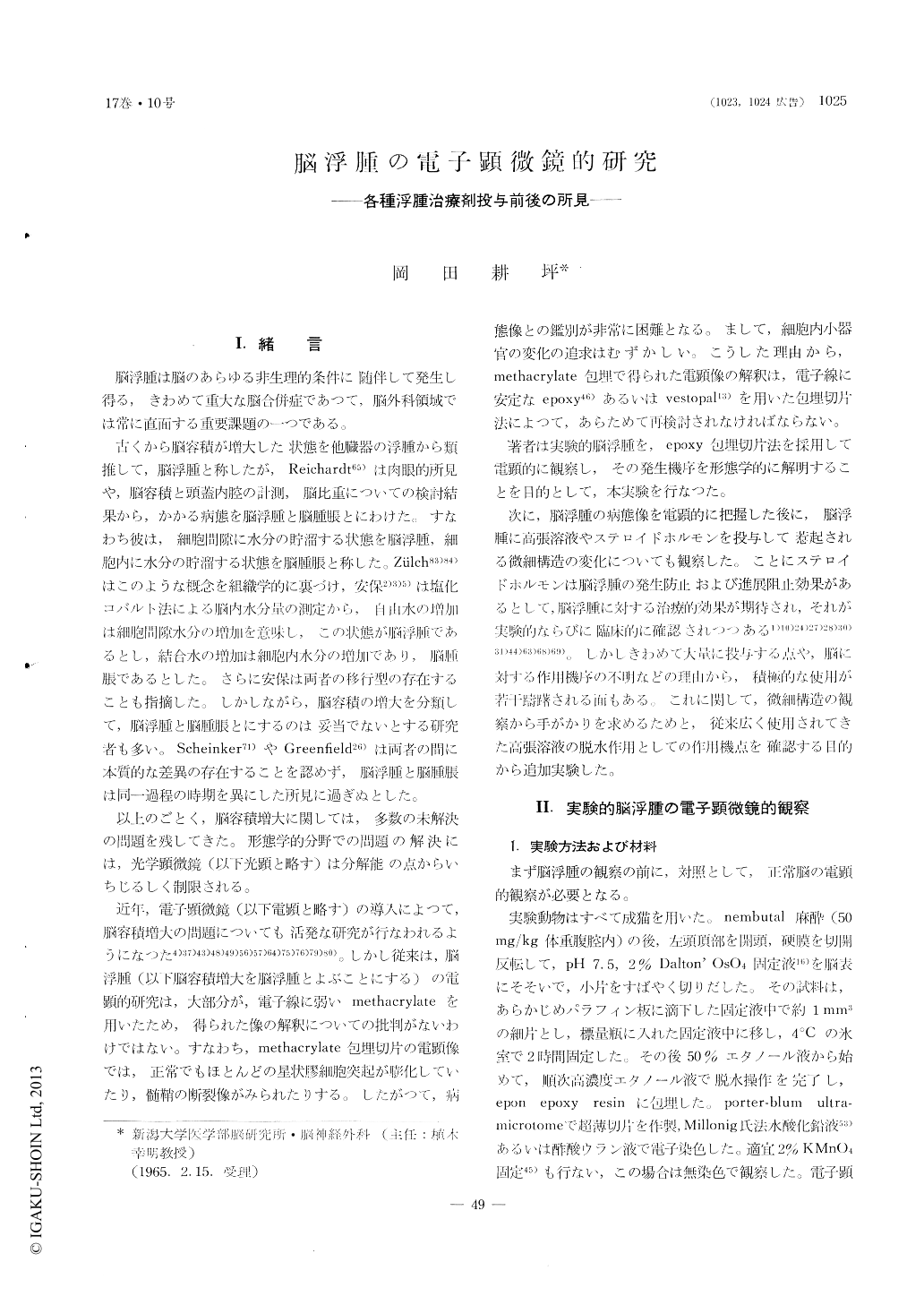Japanese
English
- 有料閲覧
- Abstract 文献概要
- 1ページ目 Look Inside
I.緒言
脳浮腫は脳のあらゆる非生理的条件に随伴して発生し得る,きわめて重大な脳合併症であつて,脳外科領城では常に直面する重要課題の一つである。
古くから脳容積が増大した状態を他臓器の浮腫から類推して,脳浮腫と称したが,Reichardt65)は肉眼的所見や,脳容積と頭蓋内腔の計測,脳比重についての検討結果から,かかる病態を脳浮腫と脳腫脹とにわけた。すなわち彼は,細胞間隙に水分の貯溜する状態を脳浮腫,細胞内に水分の貯溜する状態を脳腫脹と称した。Zülch83)84)はこのような概念を組織学的に裏づけ,安保2)3)5)は塩化コバルト法による脳内水分量の測定から,自山水の増加は細胞間隙水分の増加を意味し,この状態が脳浮腫であるとし,結合水の増加は細胞内水分の増加であり,脳腫脹であるとした。さらに安保は両者の移行型の存在することも指摘した。しかしながら,脳容積の増大を分類して,脳浮腫と脳腫脹とにするのは妥当でないとする研究者も多い。Scheinker71)やGreenfield26)は両者の間に本質的な差異の存在することを認めず,脳浮腫と脳腫脹は同一過程の時期を異にした所見に過ぎぬとした。
Brain edema was induced experimentally by the compression exerted with the extradurally inserted balloon in adult cats. Some of these animals with brain edema were then treated by administration of either hypertonic solution or steroid hormone. Morphological characteristcs of the brain edema thus made and the alterations induced by the treatments were studied by means of electron microscopy.
A. Capillary endothelium of the edematous brains not treated shows increased pinocytotic activity and some parts of the pericapillary basement membrane are splitted into two sheets, the cleft between which contains collagenous fibrils and vesicular structures with diameter of 500 to 700Å. Astrocytes of these brains are swollen extreamly, and contain an increased number of specific fine granules of 500 to 700Å in diameter which are considered to be characteristics of astrocytes. These granules are fixed well by potassium permanganate, stained distinctly by uranyl acetate, and not digested by saliva, thus being considered to be neither glycogen nor RNP granules, but glycoprotein or glycolipid in nature. Mitochondria of nerve cells in these brains are vacuolized and their cristae deranged, while such intracytoplasmic membranous structures of these neurons as endopl-asmic reticulum and nuclear envelope, are distended markedly. In spite of these marked changes, inter-cellular spaces in these edematous brains are not expanded and seem quite similar to those in normal brains.
From these findings, the blood brain barrier may be the integrated function of the capillary endothe-lium, the pericapillary basement membrane and the process of astrocyte. The brain edema might be brought about by dysfunction of the blood brain barrier. Of particular interest is the increment of the specific fine granules in the astrocyte of the edematous brain. These granules, though their nature is not yet clear, seem to reflect, at least partly, the states of the astrocytic metabolic activity, the disorder of which is suggested to be one of the decisive causes of brain edema, in addition to the derangement of the endothelium and basement membrane.
B. When hypertonic solution is administered to the animals with the brain edema induced experimentally, the pinocytotic activity of the capillary endothelium is not so marked as in the case of non-treated edematous brain, and resembles to that of normal one, though the pericapillary basement membrane shows the same changes as observed in non-treated cases.
Astrocytic processes seem not swollen by this time, but the unusual increment of the specific fine granules is perceivable as yet. Nerve cells show now normal appearance, their mitochondria and mitochondrial cristae showing little changes and endoplasmic reticulum and nuclear envelope being not distended. No alteration of the intercellular space is noted.
These fine structural manifestations of hypertonic solution to the edematous brain would confirm the process of dehydration as having been proposed to the effect of such osmo-therapy.
C. When steroid hormone (predonisolone) is pro-phylactically administered previvous to or immediately after compression of the brain, capillary endothelium and pericapillary basement membrane present no abnormality, and the cleft formation in basemet membrane and occurrence of collagenous fibrils in them cannot be recognized. Astrocytic processes, which are not dilated, contain only moderate number of specific granules, but are crowded with increased and concentrated mitochondria. Nerve cells do not show any morphological changes after administration of steroid hormone.
It might be said electronmicroscopically that predo-nisolone protects the blood brain barrier from the damage of noxious agents against the brain and prevent the occurrence of brain edema, although its chemical or metabolic mechanism in the brain is not clear at present.

Copyright © 1965, Igaku-Shoin Ltd. All rights reserved.


